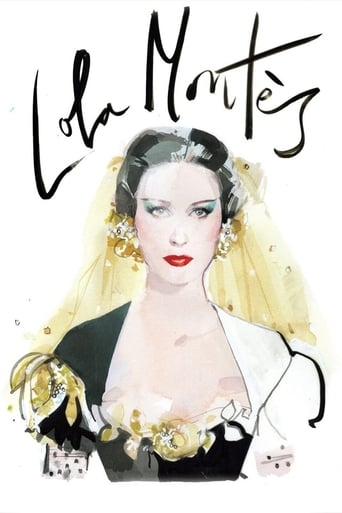erictopp
It is a great shame that Max Ophuls only made one colour wide-screen movie - this one. The master of the tracking shot might have done so much more but this was his last completed movie.The scenes are mostly well-directed and beautifully photographed but the main problem with "Lola Montès" is Lola. It is impossible for the viewer to understand how this plain, charmless woman (underplayed by Martine Carol) could seduce and inspire composers and kings. Where is the beauty, the sexiness, the vivacity of Lola? I am not asking for a documentary but the real life story of Lola is so much more interesting. I know that Ophuls is commenting on the downside of celebrity - Lola wants to be a star and ends up in a circus (if Ophuls made this today, Lola would appear in a TV "reality" show or sex tape) - but without a compelling central character the spectacle falls as flat as the cardboard cutouts of Lola.
Claudio Carvalho
In the Nineteenth Century, the Irish born dancer Lola Montès (Martine Carol) was the lover of many famous men, including Franz Liszt and the King Ludwig I of Bavaria, who made her Countess of Landsfeld. With a revolutionary movement, she flees from Munich and travels to the United States of America. She is hired by the Circus Master (Peter Ustinov) that tells her scandalous love affairs in every show and she becomes the lead attraction of the circus. "Lola Montès" is not my favorite Max Ophüls film, but it is certainly his best work of cinematography, costumes and art decoration. The restored DVD highlights these aspects and it recalls Luchino Visconti style. However, the narrative of the life of the most scandalous European woman of the Nineteenth Century is tiresome in many moments. My vote is seven.Title (Brazil): "Lola Montèz"
jonathan-577
Max Ophuls' final film, which I viewed in its restored German version, is quite the visual onslaught in widescreen - the extravagant framing device depicting the historic bed-hopper as a circus 'freak' among many, many acrobats and jugglers is the work of someone slaving feverishly to dazzle us. The distanced spectacle sucks us in, and it all looks great, but the toil of the film-making efforts end up deflecting attention from Lola herself - maybe Martine Carol isn't up for the job like everyone says, but more importantly all that metaphor stuff seems to crowd out time she could use to draw us in. The dalliance in the palace through the third act supplies Ophuls' requisite plot disfigurement - everything I've seen except Madame De... has SOME kind of unsatisfying ding in the arc. And the 'sumptuous' color compositions - which are pretty overwhelming in and of themselves, especially when the restoration is working from top sources - seem to limit the opportunities for the big Ophuls Camera Swoops that usually lively things up.
writers_reign
... she doesn't get it here and it is difficult to know where she WOULD get it. Max Ophuls was one of if not THE most elegant director who ever looked thru a viewfinder whilst conversely Martine Carol was one of the most wooden performers since Laurence Harvey so what we're left with is a case of the irresistible force meeting the immovable object. They were never going to cram all the events of Lola's life into even a four-hour movie, all the more surprising since she was dead at 40 and squeezed all her scandalous living into just over half that time. Ophuls, master of black and white story telling opted for color in what turned out to be his last film and we can only speculate by how far he would have eclipsed say Minelli had he lived. What emerges thru all the truncated and reconstructed versions is little more than a blueprint for a masterpiece manque. 7/10




